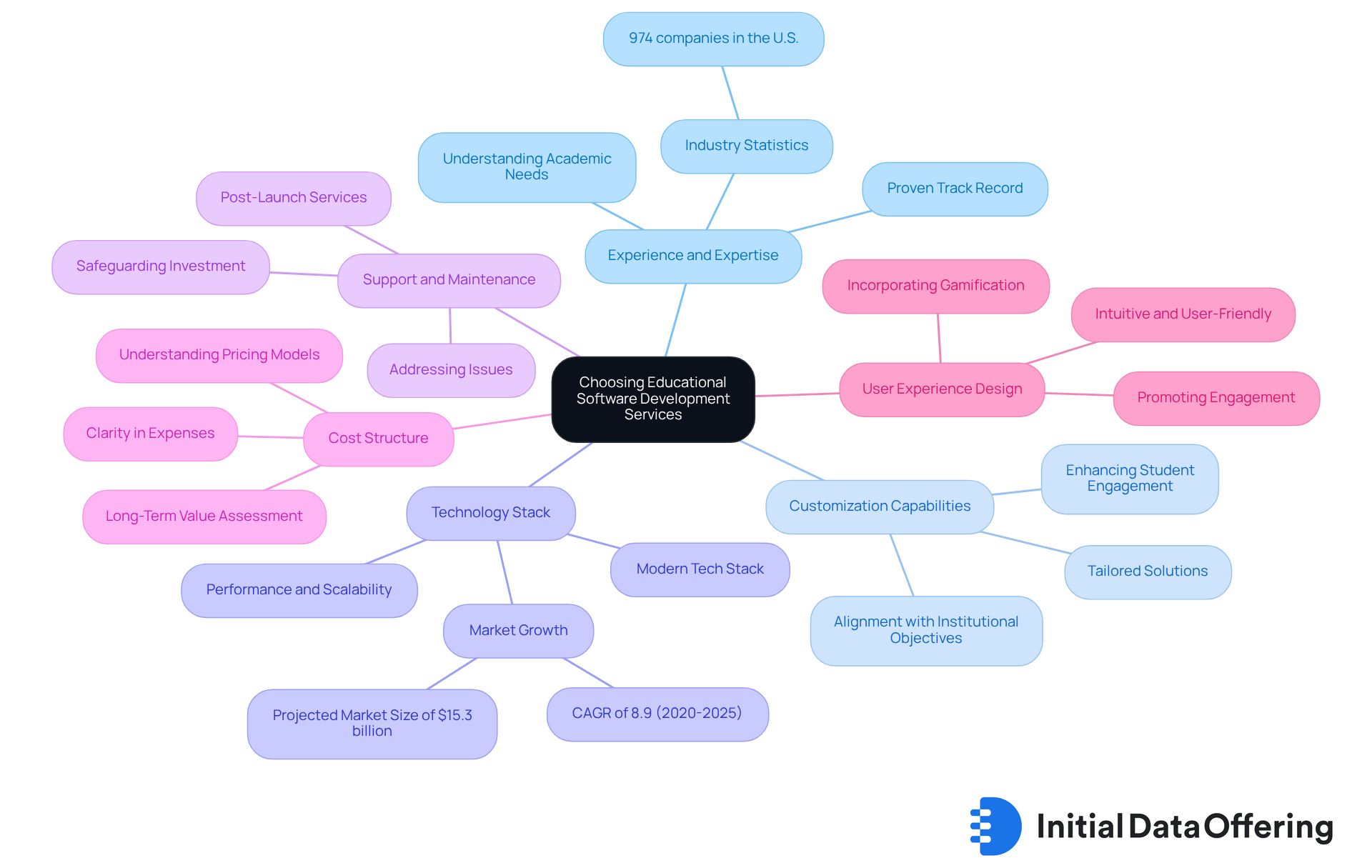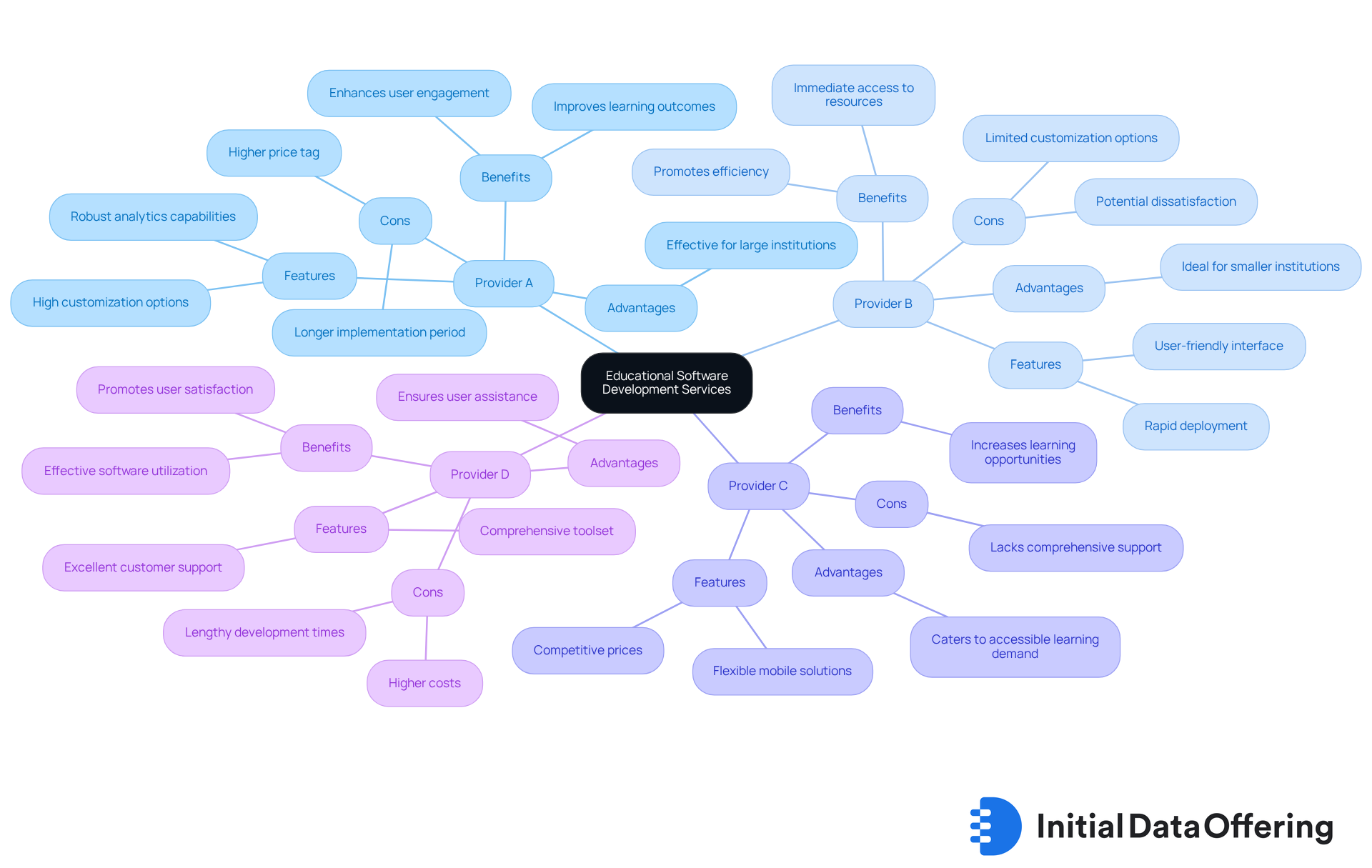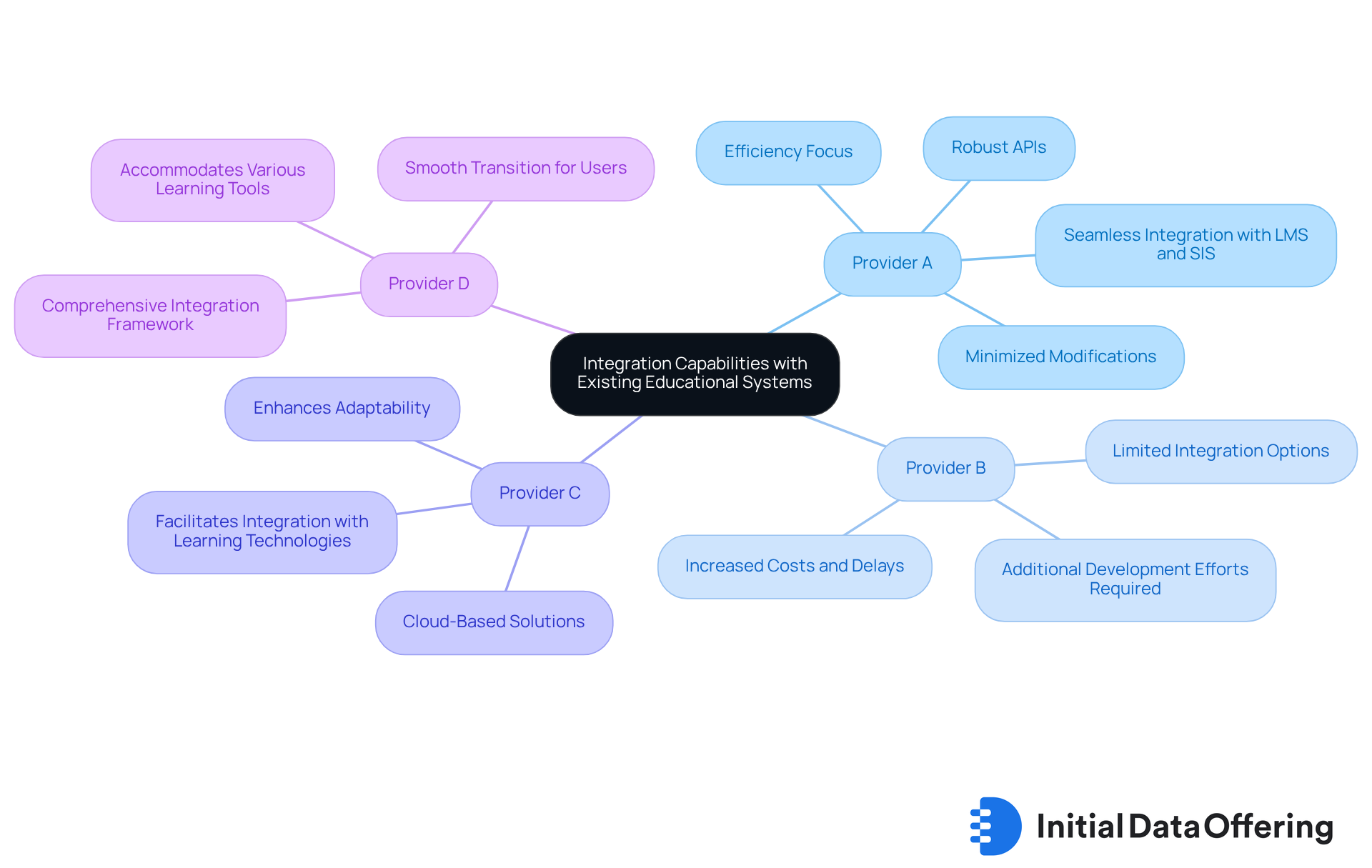4 Key Factors to Compare Educational Software Development Services

4 Key Factors to Compare Educational Software Development Services
Introduction
Choosing the right educational software development service is pivotal for an institution's digital learning strategy. With the market rapidly evolving and projected to reach $15.3 billion by 2025, understanding the key factors influencing this decision is essential for educators and administrators. What should institutions prioritize when evaluating potential providers?
By examining critical elements such as:
- Experience
- Customization
- Technology stack
- Support
we can navigate the complexities of selecting the ideal partner for educational software development. Each of these features offers distinct advantages: experience ensures reliability, customization caters to specific needs, a robust technology stack enhances functionality, and strong support guarantees ongoing assistance.
These factors not only contribute to the overall value of the service but also impact adaptability and user experience. As institutions consider their options, they must ask themselves: How do these elements align with our goals? What benefits can we expect from a well-chosen partner? By raising these questions, we encourage thoughtful consideration of the implications for effective digital learning.
Key Factors in Choosing Educational Software Development Services
When selecting educational software development services, several key factors should be considered:
-
Experience and Expertise: Prioritize providers with a proven track record in learning application development. This is particularly important for those who understand the unique needs of academic institutions. With over 974 companies in the U.S. instructional technology sector, choosing a provider with relevant experience can significantly influence project success.
-
Customization Capabilities: The ability to tailor solutions to meet specific educational requirements is crucial. This involves adjusting features for different learning settings, ensuring that the educational software development services align with institutional objectives and enhance student engagement. How well can your chosen provider adapt to your needs?
-
Technology Stack: Evaluate the technologies employed by the provider. A modern tech stack not only enhances performance and scalability but also improves user experience. This is essential in an industry that has grown at a CAGR of 8.9% between 2020 and 2025, projected to reach a market size of $15.3 billion by the end of 2025. Are you leveraging the latest technologies?
-
Support and Maintenance: Continuous assistance and upkeep are vital for the longevity of the application. Ensure the provider offers comprehensive post-launch services to address any issues that may arise, thereby safeguarding your investment. What kind of support can you expect after launch?
-
Cost Structure: Understanding the pricing model is essential for educational software development services. Seek clarity in expenses and assess the long-term value of the investment, especially as learning institutions increasingly depend on digital solutions to improve learning outcomes. Is the cost justified by the benefits?
-
User Experience Design: The application should be intuitive and user-friendly, promoting engagement among students and educators alike. Platforms that prioritize user experience, including gamification and interactive elements, are more likely to foster effective learning environments. How does the design enhance the learning experience?

Comparative Analysis of Services Offered by Leading Providers
When comparing leading educational software development services providers, it's essential to consider several key aspects that can impact your decision-making process.
-
Provider A specializes in educational software development services, particularly in Learning Management Systems (LMS) that come equipped with robust analytics features. This allows for in-depth tracking of learner progress and outcomes, which can significantly enhance educational effectiveness. However, while they offer extensive customization options, this comes at a higher price point, which may be a consideration for budget-conscious institutions.
-
Supplier B is recognized for its user-friendly interfaces and rapid deployment times, making it an attractive option for organizations looking to implement educational software development services quickly. The ease of use can lead to faster adoption among users, which is a significant advantage. However, it's worth noting that their customization options are limited, which might not meet the diverse learning needs of all users.
-
Supplier C focuses on providing educational software development services for mobile solutions, creating a flexible learning atmosphere that caters to the needs of today’s learners who are often on the go. Their competitive pricing is a notable benefit, but they do lack comprehensive support services, which could be a drawback for institutions requiring more assistance.
-
Supplier D provides a complete range of educational software development services, including evaluation and reporting features that can help educators assess learner performance effectively. They are known for excellent customer support, which can be invaluable during implementation. However, potential clients should be aware that they may require longer development times, which could delay deployment.
This analysis highlights that while some providers excel in specific areas, others may offer a more balanced approach. As you consider these options, reflect on which features align best with your institution's goals and needs. What aspects are most critical for your educational environment?

Pros and Cons of Each Educational Software Development Service
A comprehensive analysis of educational software development services reveals distinct advantages and disadvantages for each provider:
-
Provider A:
- Features: High customization options, robust analytics capabilities.
- Advantages: Particularly effective for large institutions needing tailored solutions.
- Benefits: Enhances user engagement and learning outcomes through personalization.
- Cons: Comes with a higher price tag and requires a longer implementation period, which may deter some organizations.
-
Provider B:
- Features: User-friendly interface, rapid deployment.
- Advantages: Ideal choice for smaller institutions looking for quick solutions.
- Benefits: Facilitates immediate access to learning resources, promoting efficiency.
- Cons: Limited customization options may not fulfill all specific institutional needs, potentially leading to dissatisfaction.
-
Provider C:
- Features: Flexible mobile solutions at competitive prices.
- Advantages: Caters to the growing demand for accessible learning.
- Benefits: Increases learning opportunities for users on the go.
- Cons: Lacks comprehensive support, which can be a drawback for organizations requiring ongoing assistance.
-
Provider D:
- Features: Comprehensive toolset, excellent customer support.
- Advantages: Ensures users have the help they need.
- Benefits: Promotes user satisfaction and effective utilization of the software.
- Cons: Development times can be lengthy, and costs may be higher, which could impact budget-conscious organizations.
User feedback indicates that 82% of Learning and Development professionals prioritize reporting and analytics features in an LMS. This highlights the importance of these capabilities across all providers. Additionally, case studies show that institutions often favor providers that offer tailored solutions. Customization within educational software development services can significantly enhance user engagement and learning outcomes. For instance, the global LMS market is projected to be valued at $22.4 billion by 2023, reflecting the increasing demand for effective learning management systems. Moreover, the eLearning market is anticipated to surpass $375 billion by 2026, underscoring the growing significance of technology in improving learning experiences.

Aligning Services with Market Research Analyst Needs
Market research analysts require software that streamlines data analysis, reporting, and collaboration. Let’s explore how various services meet these essential needs:
-
Provider A: This service offers advanced analytics tools designed to help analysts interpret educational data effectively. The advantage here is that it supports in-depth research projects, enabling analysts to derive meaningful insights that can drive decision-making.
-
Supplier B: With its collaborative capabilities, this provider offers educational software development services that allow analysts to work seamlessly with educators and stakeholders. This not only improves communication but also enhances project outcomes, fostering a more integrated approach to research.
-
Entity C: Emphasizing mobile accessibility, this service enables analysts to collect and evaluate data on the go. The benefit of this feature is clear: it facilitates prompt decision-making, which is crucial in today’s fast-paced environment.
-
Supplier D: This provider includes comprehensive reporting features that empower analysts to present their findings clearly and effectively. Such capabilities are ideal for formal presentations and stakeholder meetings, ensuring that insights are communicated with precision.
How might these features enhance your data analysis processes? By considering the advantages and benefits of each provider, you can make informed decisions that align with your research objectives.

Integration Capabilities with Existing Educational Systems
Integration with existing educational systems is a critical factor when selecting software development services. Understanding how various providers compare can help institutions make informed decisions:
- Provider A: Offers robust APIs that enable seamless integration with popular Learning Management Systems (LMS) and Student Information Systems (SIS). This feature not only enhances current systems but also minimizes the need for extensive modifications, making it an excellent choice for institutions aiming for efficiency.
- Supplier B: Provides limited integration options, which may necessitate additional development efforts to ensure compatibility with other learning tools. This could lead to increased costs and potential delays, raising questions about the overall value of this choice.
- Provider C: Focuses on cloud-based solutions that naturally facilitate integration with various learning technologies. This approach enhances adaptability, allowing organizations to respond swiftly to evolving learning requirements, which is crucial in today’s fast-paced educational landscape.
- Provider D: Features a comprehensive integration framework that accommodates a wide range of learning tools. This capability ensures a smooth transition for users, particularly beneficial for institutions looking to streamline operations and improve user experience.
The significance of effective integration is underscored by the fact that over 90% of developers utilize APIs in some capacity. Many developers indicate that APIs are essential for enhancing innovation and operational efficiency. As Anthea Santos pointed out, 'high-quality learning environments must incorporate intercultural education and inclusion as key components of school culture.' Furthermore, the API management market is projected to reach $5.1 billion by 2023, highlighting the increasing importance of APIs in learning application development. As educational institutions increasingly depend on technology, the ability to merge new applications with existing systems will be crucial for their success. For instance, the California State University AI Partnership exemplifies how integrating AI tools can enhance learning resources and support for students and faculty.

User Feedback and Case Studies
User feedback and case studies are invaluable for evaluating the effectiveness of educational software development services. Here’s a summary of insights from users:
- Provider A: Users praise its customization capabilities, noting that while these features are beneficial, the implementation process can be lengthy. This highlights the need for careful planning during deployment.
- Supplier B: Feedback emphasizes its user-friendly interface, which enhances accessibility for users. However, some users desire more advanced features, suggesting a potential area for improvement.
- Entity C: Users value the mobile accessibility, allowing for learning on-the-go. Yet, there are concerns regarding the absence of support, indicating a gap that could affect user satisfaction.
- Provider D: Case studies show successful implementations in large institutions, with users commending the comprehensive support provided. This underscores the importance of robust support systems in educational software.
In the context of current trends, it's noteworthy that 86% of education organizations now use generative AI, reflecting a significant shift in the industry. As Bill Gates expressed, 'As we look forward to the next century, leaders will be those who empower others,' highlighting the significance of effective learning solutions. Furthermore, the case study on 'Investment in eLearning Content Creation' demonstrates the resource-intensive nature of creating effective training materials, further supporting the discussion on the efficacy of learning tools.
Overall, the effectiveness of educational software is often reflected in user experiences and documented case studies. This underscores the importance of thorough evaluation when selecting educational software development services. How can these insights inform your choice of educational software? Consider the features and support systems that align with your organization's needs.

Conclusion
Selecting the right educational software development services is a critical decision for institutions aiming to enhance their learning environments. Understanding key factors such as:
- Experience
- Customization capabilities
- Technology stack
- Support and maintenance
- Cost structure
- User experience design
is essential. Each of these elements plays a vital role in ensuring that the chosen software effectively meets the unique needs of educational institutions.
Not all providers are created equal. Some excel in specific areas, such as robust analytics or user-friendly interfaces, while others may offer comprehensive support or mobile solutions. By comparing the strengths and weaknesses of various providers, institutions can make informed decisions that align with their educational goals and operational requirements. How can institutions leverage these insights to enhance their learning environments? The growing significance of tailored solutions and effective integration with existing systems is evident in today’s educational landscape.
Ultimately, the choice of educational software development services can significantly impact the effectiveness of learning outcomes. Institutions are encouraged to prioritize their specific needs and consider the long-term value of their investment. As the demand for innovative educational solutions continues to rise, leveraging the right technology will be essential for fostering engaging and effective learning experiences. What steps can institutions take today to ensure they are making the best choice for their future?
Frequently Asked Questions
What key factors should be considered when choosing educational software development services?
Key factors include experience and expertise, customization capabilities, technology stack, support and maintenance, cost structure, and user experience design.
Why is experience and expertise important in selecting a provider?
Experience and expertise are crucial as they indicate a provider's proven track record in learning application development, particularly in understanding the unique needs of academic institutions.
How important are customization capabilities in educational software?
Customization capabilities are vital as they allow solutions to be tailored to specific educational requirements, ensuring alignment with institutional objectives and enhancing student engagement.
What role does the technology stack play in educational software development?
The technology stack affects performance, scalability, and user experience. A modern tech stack is essential in an industry projected to grow significantly, enhancing the overall effectiveness of the software.
What should institutions look for regarding support and maintenance?
Institutions should ensure that the provider offers comprehensive post-launch support and maintenance services to address any issues, safeguarding their investment in the software.
Why is understanding the cost structure important?
Understanding the cost structure is essential to assess expenses and determine the long-term value of the investment, particularly as institutions depend more on digital solutions for improved learning outcomes.
How does user experience design impact educational software?
User experience design is crucial as it should be intuitive and user-friendly, promoting engagement among students and educators, and fostering effective learning environments through features like gamification and interactivity.
What are the strengths and weaknesses of Provider A?
Provider A specializes in Learning Management Systems with robust analytics features for tracking learner progress, but their extensive customization options come at a higher price point.
What advantages does Supplier B offer?
Supplier B is known for user-friendly interfaces and rapid deployment times, facilitating faster adoption among users, although their customization options are limited.
What is unique about Supplier C's services?
Supplier C focuses on mobile solutions, catering to learners on the go with competitive pricing, but they lack comprehensive support services.
What does Supplier D provide?
Supplier D offers a complete range of educational software development services, including evaluation and reporting features, and is known for excellent customer support, though they may require longer development times.